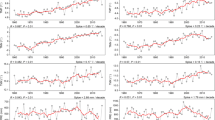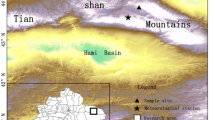Abstract
Global warming has exacerbated the instability of the climate and has led to the frequent occurrence of extreme cold and warm events. The complex geography of the high-latitude region of China's monsoon-continental transition zone makes it extremely sensitive to climate response, understanding temperature changes over long periods of time is crucial to revealing trends in climate change trends. In this study, we constructed a standardized tree-ring width chronology of Korean spruce growing in this area from 1845 to 2016 and used it to analyzed the response of the radial growth of Korean spruce to climatic factors such as temperature and precipitation. The results show that the annual mean temperature was the dominant climatic factor affecting the growth of Korean spruce. Hence, we reconstructed the annual mean temperature series of this region spanning the past 172 years. The analysis results show that the study area experienced five warm periods and five cold periods in the past 172 years. Cold years were dominant before 1960s, while temperature continuously rose and changed drastically in the early twenty-first century. The reconstructed annual mean temperature series has variability cycles of 3a, 7a, 10–12a, 15–22a and 30–40a. The results of this reconstruction enrich the tree-ring database in the representative regions of the monsoon-continental climate transition zone in China and provide a reference for systematically understanding the climate change patterns in the representative regions of the transition zone.







Similar content being viewed by others
Data availability
Data are available with the corresponding author.
References
Blasing T, Solomon A, Duvick D (1984) Response functions revisited. Tree-Ring Bull 44:1–15
Chen F, Mambetov B, Maisupova B, Kelgenbayev N (2017) Drought variations in Almaty (Kazakhstan) since AD 1785 based on spruce tree rings. Stoch Env Res Risk Assess 31:2097–2105. https://doi.org/10.1007/s00477-016-1290-y
Cook ER, Meko DM, Stahle DW, Cleaveland MK (1999) Drought reconstructions for the continental United States. J Climate 12:1145–1162
Cook ER (1986) Users manual for program ARSTAN. In: Tree-ring chronologies of western North America, California, eastern Oregon and northern Great Basin. Tree-ring chronologies of western North America, California, Eastern Oregon
D’Arrigo R, Cook ER, Wilson RJ, Allan R, Mann ME (2005) On the variability of ENSO over the past six centuries. Geophys Res Lett. https://doi.org/10.1029/2004GL022055
Fritts HC (1972) Tree rings and climate. Sci Am 226:92–101
Gao T, Wang H, Zhou T (2017) Changes of extreme precipitation and nonlinear influence of climate variables over monsoon region in China. Atmos Res 197:379–389
Guttu S, Orsolini Y, Stordal F, Otterå OH, Omrani N-E (2021) The 11 year solar cycle UV irradiance effect and its dependency on the Pacific Decadal Oscillation. Environ Res Lett 16:064030. https://doi.org/10.1088/1748-9326/abfe8b
Hennessy K, Lawrence J, Mackey B (2022) IPCC Sixth Assessment Report (AR6): Climate Change 2022-Impacts, Adaptation and Vulnerability: Regional Factsheet Australasia
Huang R, Zhu H, Liang E, Liu B, Shi J, Zhang R, Yuan Y, Grießinger J (2019) A tree ring-based winter temperature reconstruction for the southeastern Tibetan Plateau since 1340 CE. Climate Dyn 53:3221–3233. https://doi.org/10.1007/s00382-019-04695-3
Jiang Y, Wang B, Dong M, Huang Y, Wang M, Wang B (2015) Response of daily stem radial growth of Platycladus orientalis to environmental factors in a semi-arid area of North China. Trees 29:87–96. https://doi.org/10.1007/s00468-014-1089-8
Jiang Y, Wang Y, Zhang J, Han S, Coombs CE, Escobedo M, Wang J, Wang X, Hao L, Li G (2020) Tree-ring reconstruction of June–July mean temperatures in the northern Daxing’an Mountains China. Geochronometria 47:13–22. https://doi.org/10.2478/geochr-2020-0007
Jiang Y, Cao Y, Zhang J, Li Z, Shi G, Han S, Coombs CE, Liu C, Wang X, Wang J (2021) A 168-year temperature recording based on tree rings and latitude differences in temperature changes in northeast China. Int J Biometeorol 65:1859–1870. https://doi.org/10.1007/s00484-021-02142-9
Jiao L, Jiang Y, Zhang W, Wang M, Zhang L, Zhao S (2015) Divergent responses to climate factors in the radial growth of Larix sibirica in the eastern Tianshan Mountains northwest China. Trees 29:1673–1686. https://doi.org/10.1007/s00468-015-1248-6
Keyimu M, Li Z, Zhang G, Fan Z, Wang X, Fu B (2020) Tree ring–based minimum temperature reconstruction in the central Hengduan Mountains China. Theoret Appl Climatol 141:359–370. https://doi.org/10.1007/s00704-020-03169-5
Lara A, Villalba R, Urrutia-Jalabert R, González-Reyes A, Aravena JC, Luckman BH, Cuq E, Rodríguez C, Wolodarsky-Franke A (2020) + A 5680-year tree-ring temperature record for southern South America. Quat Sci Rev 228:106087. https://doi.org/10.1016/j.quascirev.2019.106087
Leonelli G, Coppola A, Salvatore MC, Baroni C, Battipaglia G, Gentilesca T, Maggi V (2017) Climate signals in a multispecies tree-ring network from central and southern Italy and reconstruction of the late summer temperatures since the early 1700s. Climate of the Past 13:1451–1471
Li J, Yuan Y, You X (2000) Hydrological research and application of tree-ring. Science Press
Li B, Chen Y, Shi X, Chen Z, Li W (2013) Temperature and precipitation changes in different environments in the arid region of northwest China. Theoret Appl Climatol 112:589–596. https://doi.org/10.1007/s00704-012-0753-4
Li W, Jiang Y, Dong M, Du E, Zhou Z, Zhao S, Xu H (2020) Diverse responses of radial growth to climate across the southern part of the Asian boreal forests in northeast China. Forest Ecol Manag 458:117759. https://doi.org/10.1016/j.foreco.2019.117759
Li J, Li J, Li T, Au T (2021) 351-year tree ring reconstruction of the Gongga Mountains winter minimum temperature and its relationship with the Atlantic Multidecadal Oscillation. Clim Change 165:1–19
Li J (1989) Dendroclimatology and dendrohydrology research in Xinjiang. Beijing: Meteorological (in Chinese).
Liu Y, Cai Q, Won-Kyu P, An Z, Ma L (2003) Tree-ring precipitation records from Baiyinaobao Inner Mongolia since AD 1838. Chin Sci Bull 48:1140–1145. https://doi.org/10.1007/s00704-012-0753-4McBride
Liu H, Park Williams A, Allen CD, Guo D, Wu X, Anenkhonov OA, Badmaeva NK (2013) Rapid warming accelerates tree growth decline in semi-arid forests of Inner Asia. Glob Change Biol 19:2500–2510
McBride JR (1983) Analysis of tree rings and fire scars to establish fire history. http://hdl.handle.net/10150/261223
Meko D, Graybill DA (1995) Tree-ring reconstruction of upper gila river discharge 1. J Am Water Resour Assoc 31(4):605–616. https://doi.org/10.1111/j.1752-1688.1995.tb03388.x
Michaelsen J (1987) Cross-validation in statistical climate forecast models. J Appl Meteorol Climatol 26:1589–1600
Peng Z, Qin L, Li X, Zhang H, Chen Y, Liu R, Zhang R (2020) Tree-ring-based temperature reconstruction since 1766 CE in the eastern Tianshan Mountains, arid Central Asia. Theoret Appl Climatol 142:687–699. https://doi.org/10.1007/s00704-020-03326-w
Rochner ML, Heeter KJ, Harley GL, Bekker MF, Horn SP (2021) Climate-induced treeline mortality during the termination of the little ice age in the greater Yellowstone ecoregion USA. The Holocene 31:1288–1303. https://doi.org/10.1177/09596836211011656
Shen J (2008) The compilation of China meteorological disaster Canon. China Meteorological Press, Beijing (in Chinese)
Sieck K, Nam C, Bouwer LM, Rechid D, Jacob D (2021) Weather extremes over Europe under 1.5 and 2.0 °C global warming from HAPPI regional climate ensemble simulations. Earth Syst Dyn 12:457–468. https://doi.org/10.5194/esd-12-457-2021
Song M, Yang B, Ljungqvist F, Shi F, Qin C, Wang J (2021) Tree-ring-based winter temperature reconstruction for East Asia over the past 700 years. Sci China Earth Sci 64:872–889. https://doi.org/10.1007/s11430-020-9768-9
Stokes MA, Smiley TL (1968) An introduction to tree-ring dating
Su J, Gou X, Hillerislambers J, Deng Y, Fan H, Zheng W, Zhang R, Manzanedo RD (2021) Increasing climate sensitivity of subtropical conifers along an aridity gradient. Forest Ecol Manag 482:118841. https://doi.org/10.1016/j.foreco.2020.118841
Szymański N, Wilczyński S (2021) Radial growth response of European larch provenances to interannual climate variation in Poland. Forests 12:334. https://doi.org/10.3390/f12030334
Thomas P, Farjon A (2013) Pinus koraiensis. The IUCN red list of threatened species 2013: e. T42373A2975987. 1
Venugopal V, Foufoula-Georgiou E (1996) Energy decomposition of rainfall in the time-frequency-scale domain using wavelet packets. J Hydrol 187:3–27. https://doi.org/10.1016/S0022-1694(96)03084-3
Wang Y, Liu Y, Zhang H, Wang H, Guo J, Zhang E, Wang J, Li X (2019) Temperature variability inferred from tree-ring records in Weichang region China and its teleconnection with large-scale climate forcing. Climate Dyn 52:1533–1545. https://doi.org/10.1007/s00382-018-4213-4
Wang T, Bao A, Xu W, Yu R, Zhang Q, Jiang L, Nzabarinda V (2021) Tree-ring-based assessments of drought variability during the past 400 years in the Tianshan mountains, arid Central Asia. Ecol Indicat 126:107702. https://doi.org/10.1016/j.ecolind.2021.107702
Wigley TM, Briffa KR, Jones PD (1984) On the average value of correlated time series, with applications in dendroclimatology and hydrometeorology. J Appl Meteorol Climatol 23:201–213
Wu X, Hao Z, Hao F, Zhang X, Singh VP, Sun C (2021) Influence of large-scale circulation patterns on compound dry and hot events in China. J Geophys Res Atmos 126(4):e2020JD033918
Wu X, Jiao L, Du D, Qi C, Xue R (2021) Comparison of the radial growth response of Picea crassifolia to climate change in different regions of the central and eastern Qilian mountains. Forests 12:1015
Yin H, Li M-Y, Huang L (2021) Summer mean temperature reconstruction based on tree-ring density over the past 440 years on the eastern Tibetan Plateau. Quat Int 571:81–88. https://doi.org/10.1016/j.quaint.2020.09.018
Zhou F, Gou X, Zhang J, Zhao Z, Chen Q, Cao Z (2013) Application of Picea wilsonii roots to determine erosion rates in eastern Qilian Mountains, Northwest China. Trees 27:371–378. https://doi.org/10.1007/s00468-012-0773-9
Funding
This research was supported by the National Natural Science Foundation of China [Grant Numbers 52069019, 51869016 and 51669016] and the Inner Mongolia Autonomous Region “Grassland Talents” project.
Author information
Authors and Affiliations
Contributions
All authors contributed to the study conception and design. Yingnan Wei carried out the Conceptualization, Data curation, Formal analysis and Writing—original draft. Bolin Sun and Jing Zhang helped in the Investigation and Software. Long Ma provided guidance in the Funding acquisition, Investigation, Methodology and Writing—review and editing. Quanpu Jing and Jianjun Xing helped in Resources, Sample collection and Visualization.
Corresponding author
Ethics declarations
Conflict of interest
The authors have no relevant financial or non-financial interests to disclose.
Additional information
Publisher's Note
Springer Nature remains neutral with regard to jurisdictional claims in published maps and institutional affiliations.
Rights and permissions
Springer Nature or its licensor (e.g. a society or other partner) holds exclusive rights to this article under a publishing agreement with the author(s) or other rightsholder(s); author self-archiving of the accepted manuscript version of this article is solely governed by the terms of such publishing agreement and applicable law.
About this article
Cite this article
Wei, Y., Ma, L., Sun, B. et al. Historical temperature variability in a representative high-latitude region in the monsoon-continental climate transition zone in China. Stoch Environ Res Risk Assess 37, 2173–2185 (2023). https://doi.org/10.1007/s00477-023-02387-3
Accepted:
Published:
Issue Date:
DOI: https://doi.org/10.1007/s00477-023-02387-3




